Exhibit 99.5

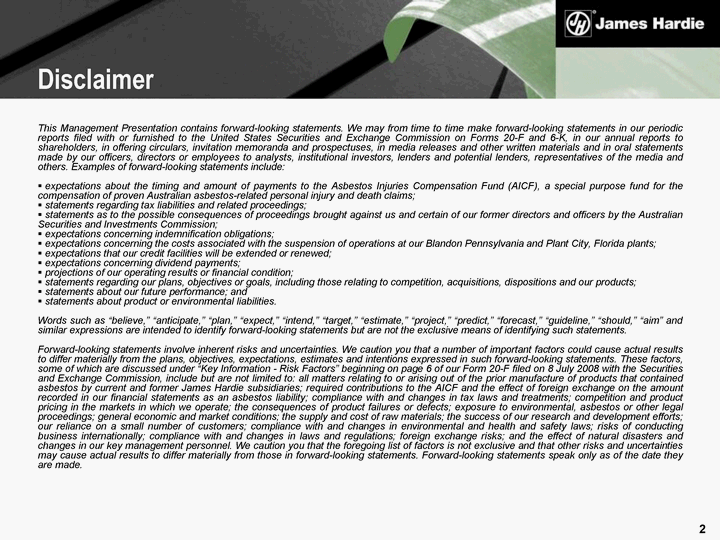
| This Management Presentation contains forward-looking statements. We may from time to time make forward-looking statements in our periodic reports filed with or furnished to the United States Securities and Exchange Commission on Forms 20-F and 6-K, in our annual reports to shareholders, in offering circulars, invitation memoranda and prospectuses, in media releases and other written materials and in oral statements made by our officers, directors or employees to analysts, institutional investors, lenders and potential lenders, representatives of the media and others. Examples of forward-looking statements include: expectations about the timing and amount of payments to the Asbestos Injuries Compensation Fund (AICF), a special purpose fund for the compensation of proven Australian asbestos-related personal injury and death claims; statements regarding tax liabilities and related proceedings; statements as to the possible consequences of proceedings brought against us and certain of our former directors and officers by the Australian Securities and Investments Commission; expectations concerning indemnification obligations; expectations concerning the costs associated with the suspension of operations at our Blandon Pennsylvania and Plant City, Florida plants; expectations that our credit facilities will be extended or renewed; expectations concerning dividend payments; projections of our operating results or financial condition; statements regarding our plans, objectives or goals, including those relating to competition, acquisitions, dispositions and our products; statements about our future performance; and statements about product or environmental liabilities. Words such as "believe," "anticipate," "plan," "expect," "intend," "target," "estimate," "project," "predict," "forecast," "guideline," "should," "aim" and similar expressions are intended to identify forward-looking statements but are not the exclusive means of identifying such statements. Forward-looking statements involve inherent risks and uncertainties. We caution you that a number of important factors could cause actual results to differ materially from the plans, objectives, expectations, estimates and intentions expressed in such forward-looking statements. These factors, some of which are discussed under "Key Information - Risk Factors" beginning on page 6 of our Form 20-F filed on 8 July 2008 with the Securities and Exchange Commission, include but are not limited to: all matters relating to or arising out of the prior manufacture of products that contained asbestos by current and former James Hardie subsidiaries; required contributions to the AICF and the effect of foreign exchange on the amount recorded in our financial statements as an asbestos liability; compliance with and changes in tax laws and treatments; competition and product pricing in the markets in which we operate; the consequences of product failures or defects; exposure to environmental, asbestos or other legal proceedings; general economic and market conditions; the supply and cost of raw materials; the success of our research and development efforts; our reliance on a small number of customers; compliance with and changes in environmental and health and safety laws; risks of conducting business internationally; compliance with and changes in laws and regulations; foreign exchange risks; and the effect of natural disasters and changes in our key management personnel. We caution you that the foregoing list of factors is not exclusive and that other risks and uncertainties may cause actual results to differ materially from those in forward-looking statements. Forward-looking statements speak only as of the date they are made. Disclaimer |
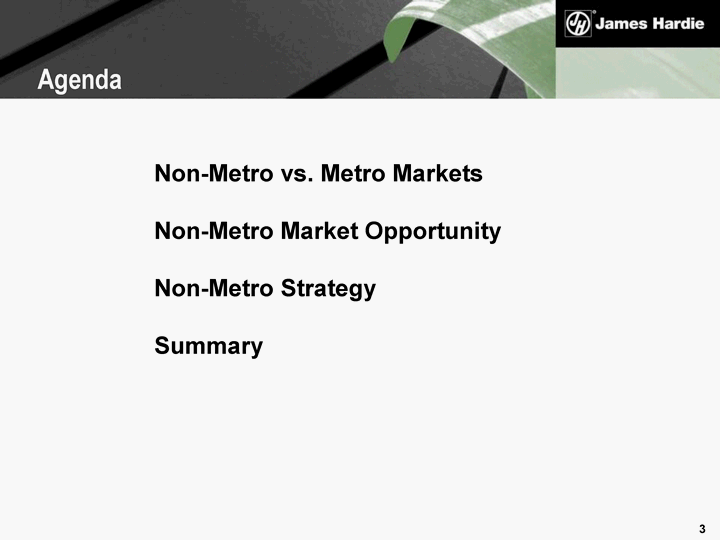
| Non-Metro vs. Metro Markets Non-Metro Market Opportunity Non-Metro Strategy Summary Agenda |
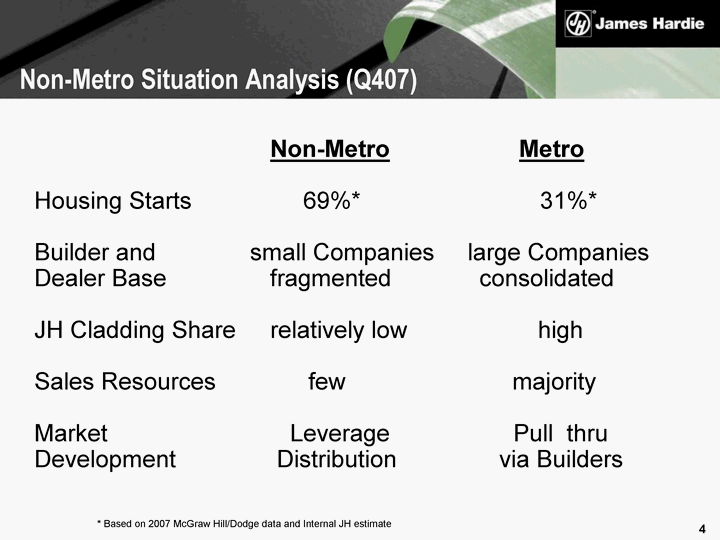
| Non-Metro Metro Housing Starts 69%* 31%* Builder and small Companies large Companies Dealer Base fragmented consolidated JH Cladding Share relatively low high Sales Resources few majority Market Leverage Pull thru Development Distribution via Builders * Based on 2007 McGraw Hill/Dodge data and Internal JH estimate Non-Metro Situation Analysis (Q407) |
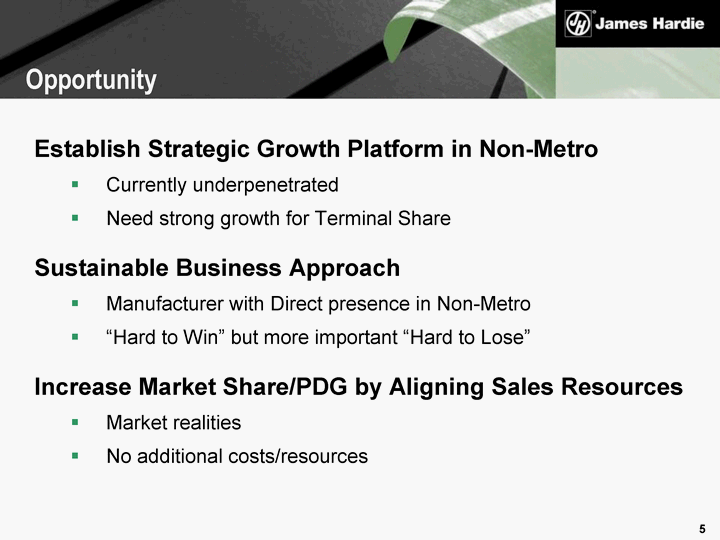
| Establish Strategic Growth Platform in Non-Metro Currently underpenetrated Need strong growth for Terminal Share Sustainable Business Approach Manufacturer with Direct presence in Non-Metro "Hard to Win" but more important "Hard to Lose" Increase Market Share/PDG by Aligning Sales Resources Market realities No additional costs/resources Opportunity |
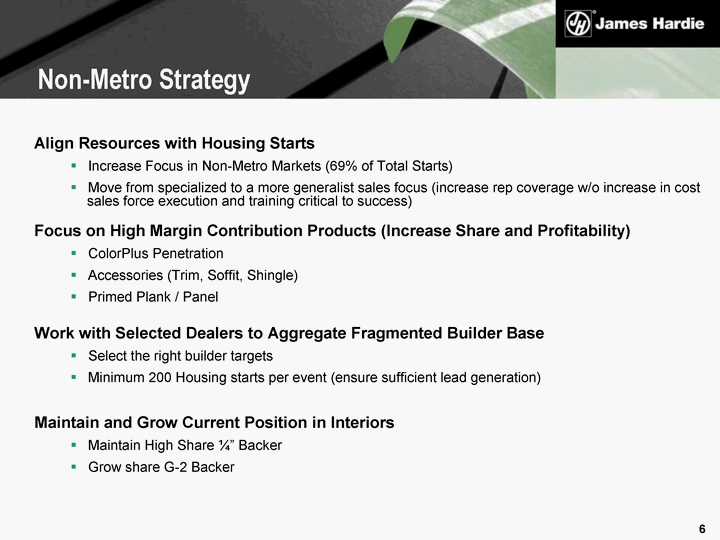
| Align Resources with Housing Starts Increase Focus in Non-Metro Markets (69% of Total Starts) Move from specialized to a more generalist sales focus (increase rep coverage w/o increase in cost sales force execution and training critical to success) Focus on High Margin Contribution Products (Increase Share and Profitability) ColorPlus Penetration Accessories (Trim, Soffit, Shingle) Primed Plank / Panel Work with Selected Dealers to Aggregate Fragmented Builder Base Select the right builder targets Minimum 200 Housing starts per event (ensure sufficient lead generation) Maintain and Grow Current Position in Interiors Maintain High Share 1/4" Backer Grow share G-2 Backer Non-Metro Strategy |

| Rep placement follows market opportunity Methodology for Optimizing Rep Placement Begin with housing starts Adjust starts for cladding types Calculate adjusted starts per MSA & state Spread reps geographically based on adjusted starts NAHB starts Tracked by county Cladding mix impacts opportunity NAHB estimates at state level Proxy for opportunity per geographic unit Let rep placement follow opportunity Allocation to metro & non-metro flows from the numbers Allocation across states does as well Align Sales Resources to Housing Starts |

| Example: Housing Starts by County SE |

| Non-Metro Rep Builders Dealers (L. Yards) Siding Installer Tile Installer Tile/Gyp Dealer Big Box A/E R&R Contractor Customers Reps Sell full product line Primary Specialist to a more generalist approach |
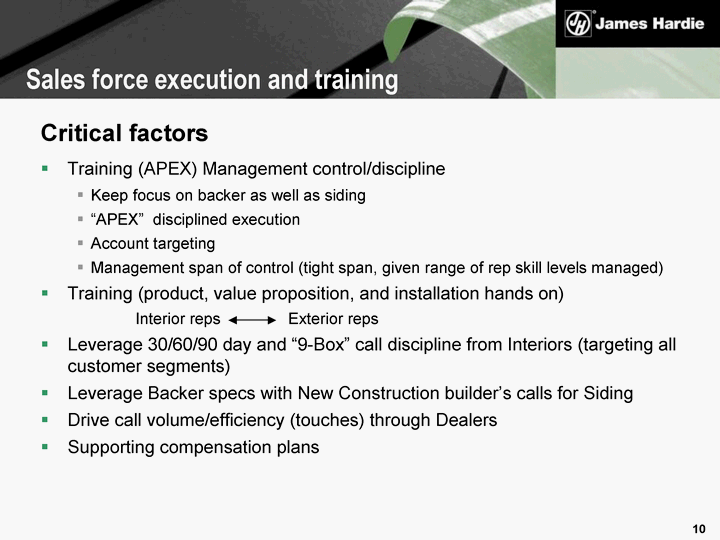
| Critical factors Training (APEX) Management control/discipline Keep focus on backer as well as siding "APEX" disciplined execution Account targeting Management span of control (tight span, given range of rep skill levels managed) Training (product, value proposition, and installation hands on) Interior reps Exterior reps Leverage 30/60/90 day and "9-Box" call discipline from Interiors (targeting all customer segments) Leverage Backer specs with New Construction builder's calls for Siding Drive call volume/efficiency (touches) through Dealers Supporting compensation plans Sales force execution and training |
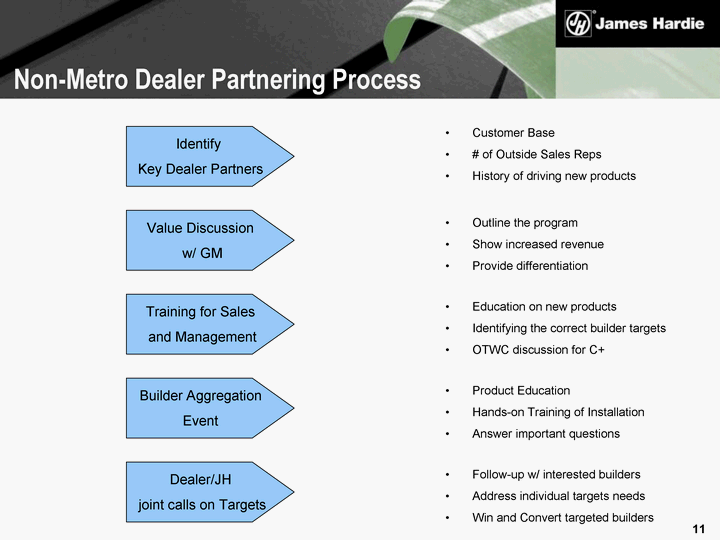
| Identify Key Dealer Partners Value Discussion w/ GM Training for Sales and Management Builder Aggregation Event Dealer/JH joint calls on Targets Follow-up w/ interested builders Address individual targets needs Win and Convert targeted builders Product Education Hands-on Training of Installation Answer important questions Education on new products Identifying the correct builder targets OTWC discussion for C+ Outline the program Show increased revenue Provide differentiation Customer Base # of Outside Sales Reps History of driving new products Non-Metro Dealer Partnering Process |
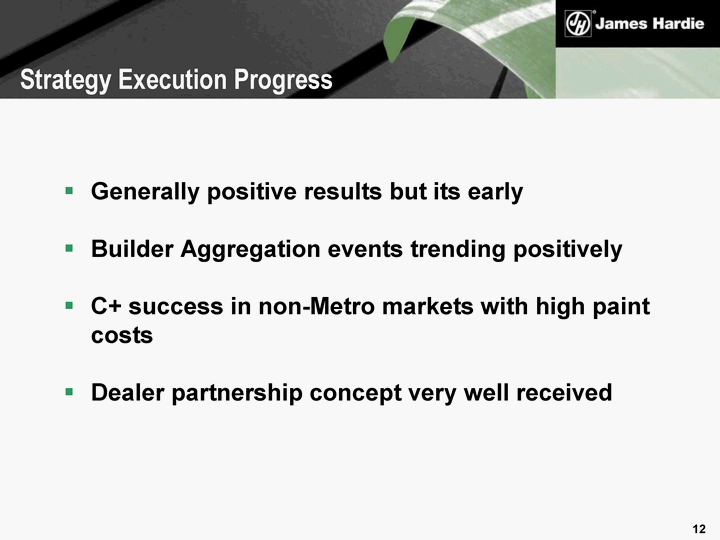
| Generally positive results but its early Builder Aggregation events trending positively C+ success in non-Metro markets with high paint costs Dealer partnership concept very well received Strategy Execution Progress |
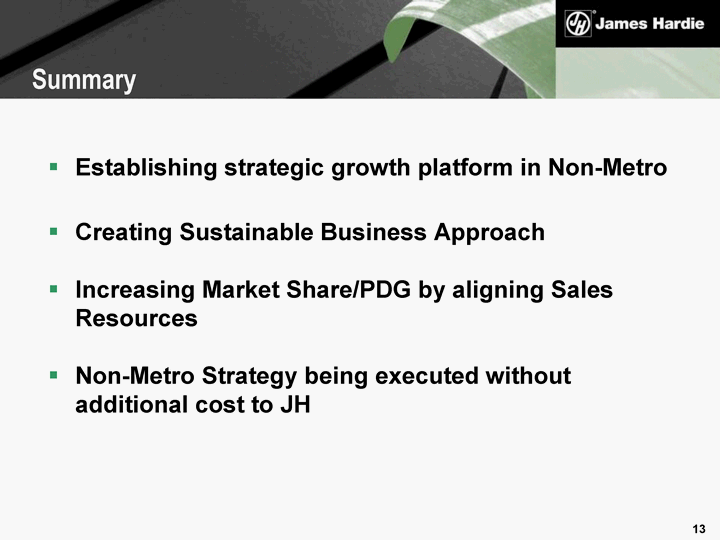
| Establishing strategic growth platform in Non-Metro Creating Sustainable Business Approach Increasing Market Share/PDG by aligning Sales Resources Non-Metro Strategy being executed without additional cost to JH Summary |